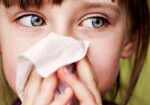Allergic Eye Disorders

بسیاری از حساسیت های چشمی یا آلرژی های چشمی که برخی از انواع آن ها به صورت التهاب ملتحمه بروز میکنند، واگیردار است.
Many eye allergies, or ocular allergies, some of which manifest as conjunctival inflammation, are contagious.
With the changes in nature, which not only alter the color and scent of the air but also bring about eye allergy symptoms for many of us, managing ocular allergies during the spring season becomes crucial. Strategies such as wearing sunglasses, using antihistamine medications, and avoiding allergens can provide significant relief for those affected by this condition. Therefore, with proper attention to eye health and the use of appropriate methods, we can easily overcome allergy season. In this article, we will explore the factors, symptoms, and management strategies for ocular allergies in the spring season
Allergy
As we explained earlier, individuals may suffer from various allergies during the spring season, and the eyes are no exception. Ocular allergies can be triggered by factors such as dust, pet dander, pollen, certain molds, and other allergens. Allergic conjunctivitis is one type of conjunctival inflammation that occurs due to seasonal allergies. This condition is very common and typically affects many people. Treatment methods for this condition vary, but it is usually manageable and can be treated effectively.
What is Allergic Conjunctivitis and What Are Its Types?
Ocular allergies, also known as allergic conjunctivitis, occur when the eyes react to environmental allergens. These allergens can cause uncomfortable symptoms, but with proper understanding and treatment, individuals can effectively manage their eye allergies. This condition can present as either acute, triggered by sudden exposure to an irritant, or chronic, where symptoms persist over time and may be nearly constant.
Acute Allergic Conjunctivitis
This type of condition occurs when the eyes are suddenly exposed to an allergen or irritant. Some cosmetics and personal care products contain these irritants. Certain soaps and shampoos may also trigger allergic reactions. Seasonal allergies can also contribute to the onset of this condition. Occasionally, contracting the flu may exacerbate the symptoms of allergic conjunctivitis.
Chronic Allergic ConjunctivitisThis type may occur due to continuous exposure to allergens such as dust, pet dander, and others. In chronic allergic conjunctivitis, inflammation may be less severe, but symptoms like burning and itching are common. Occasionally, individuals with chronic conjunctivitis may also experience light sensitivity (photophobia).
Chronic allergic conjunctivitis is sometimes mistaken for dry eye syndrome or other eye conditions, so it is essential to inform your ophthalmologist about your history of allergies and their impact on your eyes. This will allow the doctor to consider the best treatment approach based on your allergy history and tailor the management plan accordingly.
Causes of Allergic Conjunctivitis and Inflammation
As part of the body’s natural allergic reactions, a substance called histamine is released. Histamine causes blood vessels to dilate and makes the vessel walls suddenly more permeable. This leads to symptoms such as a runny nose, itching, watery eyes, and other common allergic reactions, which are essentially the body’s natural response to histamine. Treatment and management of these symptoms involve the use of antihistamine medications, which reduce allergic reactions by blocking the binding of histamine to cells in the body, thereby alleviating symptoms.
Generally, some of the causes of allergic conjunctivitis occur due to the following factors:
- Fragrances and Cosmetics:
- Certain perfumes, makeup products, and personal care items can contain irritants or allergens that trigger allergic reactions in the eyes.
- Irritants like Cigarette Smoke and Air Pollution:
- Exposure to smoke, car exhaust, and other environmental pollutants can irritate the eyes and worsen allergic symptoms.
- Pollen from Flowers and Trees:
- Pollen is a major seasonal allergen, particularly in spring and summer, and can trigger allergic conjunctivitis.
- Pet Hair and Dander:
- Proteins found in pet hair, fur, and dander, especially from cats and dogs, are common allergens that affect individuals with sensitivities.
- Seasonal Allergies:
- These occur during specific seasons, often related to high pollen levels from trees, grasses, or weeds, causing eye allergies.
- Mold Spores:
- Mold or mildew spores, commonly found in damp environments, can cause allergic eye reactions when inhaled or come into contact with the eyes.
- Dust:
- Household dust and dust mites are a year-round allergen that can trigger allergic conjunctivitis in sensitive individuals.
Symptoms of Allergic Conjunctivitis
Some common symptoms of allergic conjunctivitis include:
- Red Eyes:
The eyes appear red due to inflammation of the conjunctiva (the thin tissue covering the eye). - Severe Eye Burning:
A burning sensation in the eyes is often experienced, which can be quite uncomfortable. - Watery Eyes:
Excessive tearing or watery eyes are a common symptom, as the eyes try to flush out the allergens. - Inflamed and Swollen Eyelids:
The eyelids may become swollen and inflamed due to the allergic reaction, sometimes making it difficult to open the eyes fully.
These symptoms can be managed with antihistamines, anti-inflammatory medications, and allergen avoidance. If the symptoms persist or worsen, it is essential to seek medical advice from an ophthalmologist for further treatment.
Diagnosis of Allergic Conjunctivitis
As with all eye conditions, it is important to visit an ophthalmologist for proper diagnosis and treatment. Allergic conjunctivitis can have similar symptoms to other eye diseases, so it is essential to consult an eye specialist. The ophthalmologist, through a detailed and specialized examination, can determine the exact condition and recommend the best treatment approach. The diagnosis of allergic conjunctivitis can be made using several methods, such as:
- Specialized Examination by an Ophthalmologist
- Taking Symptoms and Medical History from the Patient:
The ophthalmologist will carefully listen to the patient’s symptoms and inquire about their medical history, including any known allergies or previous eye conditions. This helps in understanding the patient’s overall health and potential triggers for the allergic reaction. - Conducting Allergy Tests:
Allergy tests, including skin tests or blood tests, are performed to identify specific allergens (such as pollen, pet dander, or dust mites) that may be causing the allergic reaction in the eyes. Skin tests involve applying a small amount of allergen to the skin and observing for any reaction, while blood tests check for allergen-specific antibodies in the blood. - These steps help the ophthalmologist determine the exact cause of allergic conjunctivitis and allow for a more targeted and effective treatment plan.
- 4o mini
Treatment of Allergic Conjunctivitis
The treatment of allergic conjunctivitis focuses on relieving symptoms, controlling inflammation, and preventing recurrence. Common treatment strategies include:
- Avoiding Allergen Exposure:
The most important step is to minimize or avoid contact with known allergens, such as pollen, pet dander, dust, and irritants like smoke. - Use of Artificial Tears:
Lubricating eye drops help wash away allergens from the surface of the eyes and provide relief from dryness and irritation. - Antihistamine Eye Drops or Oral Antihistamines:
These medications help block the action of histamine, reducing itching, redness, and swelling. - Mast Cell Stabilizers:
Eye drops that prevent the release of histamine and other chemicals from mast cells, helping to control symptoms over time, especially in chronic cases. - Combination Eye Drops:
Some formulations combine antihistamines and mast cell stabilizers for both immediate and long-term symptom control. - Corticosteroid Eye Drops:
In severe cases, short-term use of corticosteroid eye drops may be prescribed to reduce intense inflammation. However, these should be used under close supervision by an ophthalmologist due to potential side effects. - Cold Compresses:
Applying cold compresses over closed eyes can help reduce swelling and soothe irritation. - Immunotherapy (Allergy Shots):
In cases where allergic conjunctivitis is severe and persistent, allergy immunotherapy may be recommended to gradually desensitize the immune system to specific allergens.
Early diagnosis and appropriate treatment can greatly improve comfort and prevent complications. Regular follow-up with an ophthalmologist is important for monitoring the condition and adjusting treatment if necessary.
Prevention of Allergic Conjunctivitis
By following certain guidelines, it is possible to prevent the development of allergic conjunctivitis. If you are aware of the specific type of allergy you have, adhering to these preventive measures can help control the condition:
- Limit Outdoor Activities on Windy Days:
Wind can carry large amounts of pollen and allergens, increasing exposure and symptoms. - Keep Windows Closed and Use Air Conditioning:
Keeping windows closed, especially during high pollen seasons, and using air conditioning with proper filtration can help reduce indoor allergen exposure. - Change Air Filters Regularly:
Replacing filters in air conditioning units, heaters, and other ventilation systems helps control the presence of allergens in indoor spaces. Regular cleaning to remove dust from surfaces is also beneficial. - Wash Hands with Soap and Water:
Keeping hands clean reduces the risk of transferring allergens to the eyes. - Avoid Touching or Rubbing the Eyes:
Rubbing the eyes can worsen irritation and increase the severity of allergic reactions. - Wear Sunglasses or Protective Eyewear Outdoors:
Using sunglasses can protect the eyes from airborne allergens like pollen and dust particles. - Use Allergen-Proof Covers for Pillows and Mattresses:
Special allergy covers can reduce exposure to dust mites and other indoor allergens, providing additional protection, especially while sleeping.
Implementing these preventive strategies can significantly lower the risk of allergic conjunctivitis and help maintain better eye health during allergy seasons.




